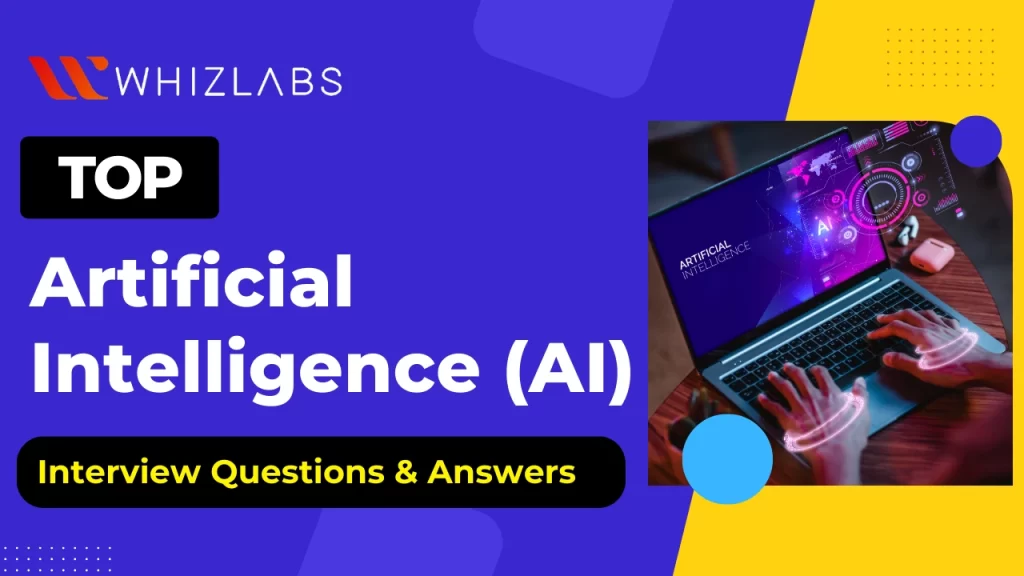Artificial Intelligence (AI) has rapidly evolved into a transformative field, leaving its footprint in almost every industry.
In today’s landscape, nearly every company seeks AI Engineers and professionals to integrate Artificial Intelligence: AI-900 into their systems, aiming to enhance the customer experience and offer additional functionalities.
When it comes to AI job interviews, both interviewers and candidates must be well-prepared. So, we have compiled Artificial Intelligence interview questions and answers to help both parties navigate the AI landscape effectively, ensuring a successful and insightful exchange during the interview process.
Let’s explore now!
Top 30 Artificial Intelligence (AI) Interview Questions & Answers
Here are a few Artificial Intelligence important Interview questions and answers for you:
Artificial Intelligence Interview Questions for Freshers
1. What is Artificial Intelligence and its types?
Artificial intelligence definition: Artificial intelligence (AI) refers to the theory and development of computer systems that can do the tasks that need historical human intelligence data, such as how to recognize speech, make decisions, and identify patterns. AI integrates some of the innovative techniques such as machine learning, deep learning, and natural language processing (NLP).
While coming to AI Types, it has been classified into seven types, they are:
- Weak AI or Narrow AI
- General AI
- Super AI
- Reactive Machines
- Limited Memory
- Theory of Mind
- Self-awareness
2. What is the difference between AI, deep learning and machine learning?
| Aspect | Artificial Intelligence (AI) | Machine Learning (ML) | Deep Learning (DL) |
| Definition | AI enables machines to emulate human brain functions. | ML involves data processing, learning, and decision-making. | DL uses Artificial Neural Networks for complex problem-solving. |
| Goal | AI aims to enable machines to think autonomously, reducing the need for human intervention. | ML’s goal is for machines to learn from past experiences. | DL employs various algorithms to address complex problems, much like the human brain. |
| Data Types | AI can handle both structured and semi-structured data. | ML is effective with structured and semi-structured data. | DL utilizes structured and unstructured data for problem-solving. |
| Hierarchy | AI falls under the umbrella of data science. | ML is a subset of AI. | DL is a subset of Machine Learning. |
| Examples | Example: Google Search engine. | Example: Image recognition. | Example: Automatic car driving system. |
3. What is Deep Learning?
Deep learning falls under the umbrella of machine learning and it utilizes artificial neural networks for resolving complex problems. The AI concepts were introduced after getting inspired by human brains. Deep learning endows the capacity to approach a problem and resolve it akin to the human brain’s approach in that context. The term ‘deep’ in deep learning signifies the abundance of concealed layers within the neural network. Deep learning models are designed with the ability to autonomously train and govern themselves.
4. Who is the father of AI?
John McCarthy, an American computer scientist, holds the esteemed title of the “father of Artificial Intelligence.” He is notably credited with coining the term “artificial intelligence” and is counted among the pioneers of this field, alongside individuals like Alan Turing, Marvin Minsky, Allen Newell, and Herbert A.
5. What are platforms available for Artificial Intelligence (AI) development?
Some of the platforms available for AI development such as:
- Amazon AI services
- Tensorflow
- Google AI services
- Microsoft Azure AI platform
- Infosys Nia
- IBM Watson
- H2O
- Polyaxon
- PredictionIO
- Salesforce
6. What are common misconceptions about artificial Intelligence?
Here are some misconceptions stated about artificial intelligence, they are:
- Machines can learn from themselves: The machines do not attain that stage where they can make their decision by themselves. Machines always learn via a process called machine learning and develop based on experiences without the need for explicit programming. Machine learning comes up with a set of computer programs to access and learn the data on their own.
- Artificial Intelligence and Machine learning are the same: Artificial Intelligence and Machine learning vary from each other. Artificial Intelligence deals with creating devices that mimic human intelligence, while machine learning is a subcategory of artificial intelligence and it involves creating programs for analyzing data, learning from it, and then making decisions.
- Artificial Intelligence replaces humans: There’s a chance that AI’s capabilities may soon equal or even surpass human intelligence. However, suggesting that AI will dominate over humans is purely a product of imagination. AI is intended to enhance human intelligence, not enslave it.
7. What are the programming languages used in Artificial Intelligence?
Python, R, Lisp, Java, Julia, C++, Javascript, and Prolog are the frequently employed programming languages in the realm of artificial intelligence.
8. Give some real-life applications of AI.
Here are some real-time applications of artificial intelligence:
- Virtual aides such as Siri and Alexa.
- Systems for suggesting products on e-commerce platforms.
- Identifying fraudulent activities within financial institutions.
- Self-driving cars.
- Natural language processing for chatbots and customer support.
- Recognizing images and faces in security systems.
- Healthcare systems for medical diagnoses.
9. What is a Bayesian network?
Bayesian network is a type of probabilistic graphical model that revolves around a collection of variables and their interconnections, presented in the structure of a graph without loops. These networks rely on the principles of probability distribution to make predictions, identify irregularities, and leverage probability theory to understand various outcomes.
Bayesian networks serve a wide range of purposes, including forecasting, anomaly detection, logical reasoning, gaining insights, diagnostic processes, and supporting decision-making. For instance, you can use a Bayesian network to visually depict the likelihood relationships between different diseases and their associated symptoms. This network can be employed to compute the probabilities of specific diseases being present based on the observed symptoms.
10. What is game theory?
Game theory is a field within artificial intelligence that seeks to model strategic interactions between two equally rational players. In this framework, each player is driven by self-interest and aims to maximize their potential reward through specific strategies. Players adhere to established rules that determine the ultimate payoff or reward they receive. So, we can describe a game as comprising players, actions, strategies, and a final reward.
Game theory was introduced due to the collaborative efforts of mathematician John von Neumann and economist Oskar Morgenstern during the 1940s. Subsequently, in the 1950s, numerous other researchers and scholars made substantial contributions to its development.
11. What is the future of artificial intelligence?
Artificial Intelligence has significantly affected various parts of human life and almost all industries, and this impact is expected to continue. AI has been crucial in developing new technologies like the Internet of Things, big data analysis, and robotics.
It has the impressive ability to handle large amounts of data and quickly make the best decisions, which would be very difficult for an average person. AI is leading in important areas for humanity, such as improving cancer research, innovative solutions for addressing climate change, smart cars, and space exploration.
AI is projected to experience a remarkable annual growth rate of 37.3% from 2023 to 2030, according to findings by Grand View Research. This sustained surge underscores the ever-expanding influence of AI technologies in the years to come, as they continue to reshape diverse industries.
Also Read : How are Big Data and AI Changing the Business World?
Artificial Intelligence Interview Questions for Advanced Learners
12. What do you mean by Q-learning?
Q-learning is a form of reinforcement learning algorithm that allows machines to learn optimal behaviors within a specific environment through a process of trial and error. It’s a widely recognized approach in the realms of machine learning and artificial intelligence, with applications spanning various domains, such as robotics, game theory, and control systems.
13. Distinguish between parametric and non-parametric models.
| Aspect | Parametric Model | Non-Parametric Model |
| Parameter Flexibility | Parametric models use a fixed number of parameters to construct the model. | Non-parametric models employ a flexible number of parameters to build the model. |
| Analysis Focus | Parametric analysis typically examines group means. | Non-parametric analysis is geared towards testing medians. |
| Applicability | Parametric models are suitable for variables. | Non-parametric models apply to both variables and attributes. |
| Versatility | Parametric methods are effective in various scenarios, with optimal performance when group dispersions differ. | Similarly, Non-Parametric methods can perform well in various conditions, excelling when group dispersions are similar. |
| Assumptions | Parametric models impose strong assumptions on the data. | Non-parametric models make fewer assumptions about the data. |
| Examples | Examples of Parametric models include Naive Bayes and logistic regression. | Examples of Non-Parametric models include KNN. |
14. How we can test the intelligence of a machine?
The Turing Test is a method in the field of artificial intelligence (AI) used to determine whether a computer can exhibit human-like thinking. It’s named after Alan Turing, an English computer scientist, cryptanalyst, mathematician, and theoretical biologist who introduced the concept.
Turing suggested that a computer could be deemed to possess artificial intelligence if it can imitate human responses in certain conditions. The original Turing Test involves three separate terminals. One terminal is controlled by a computer, while the other two are operated by humans.
In this test, one of the humans takes on the role of the questioner, while the second human and the computer act as respondents. The questioner poses questions to the respondents within a specific topic area, using predefined rules and context. After a set amount of time or a specific number of questions, the questioner is asked to determine which respondent is human and which one is a computer.
15. What is Reinforcement Learning?
Reinforcement learning is a domain within machine learning that operates on models driven by rewards to make predictions and decisions. It relies on a feedback system where a machine is rewarded for making good decisions and receives negative feedback for poor performance.
This approach motivates the machine to discover the most effective behavior in specific situations. In contrast to supervised learning, in reinforcement learning, the agent learns independently through feedback and doesn’t rely on labeled data.
Reinforcement learning is employed to address specific problems that involve sequential decision-making and have long-term objectives. This includes applications like playing games, robotics, and more.
16. What is overfitting?
Overfitting in data science occurs when a model doesn’t fit new data very well. It’s like when you teach a model with data, and it gets confused by unexpected things that don’t match its usual patterns. This happens when the model has trouble making accurate predictions with new data.
Here are some strategies to Prevent Overfitting:
- Cross-validation
- Feature Removal
- Early Stopping
- Increased Data Training
- Regularization
- Ensemble Learning
17. What is NLP?
Natural language processing (NLP) is a branch of machine learning that empowers computers to understand, manipulate, and make sense of human language.
In today’s world, organizations accumulate vast amounts of voice and text data from various sources like emails, text messages, social media updates, videos, and audio recordings. NLP technology is employed to automatically handle this data, decipher the intent or sentiment behind the messages, and provide real-time responses to human communication.
NLP plays a crucial role in effectively analyzing text and speech data, irrespective of dialects, slang, or grammatical idiosyncrasies encountered in everyday conversations. Businesses leverage NLP for numerous automated tasks, including
- Processing, analyzing, and archiving extensive documents
- Evaluating customer feedback and call center interactions
- Employing chatbots for automated customer service
- Addressing who, what, when, and where inquiries
- Categorizing and extracting relevant information from text
Furthermore, integrating NLP into customer-facing applications can enhance communication and engagement with customers.
18. What is Markov’s decision process?
Markov’s decision process (MDP) is a mathematical framework in reinforcement learning. It helps solve problems where outcomes have both random and controlled elements. To navigate a complex problem using MDP, we need:
- Agent: The entity we’re training, like a robot assisting in cooking.
- Environment: The surroundings of the agent, like the kitchen for the robot.
- State (S): It represents the current situation of the agent, including its position, temperature, posture, etc.
- Action (A): These are the moves or decisions the agent can make, such as moving left or passing an onion.
- Policy (𝜋): The strategy or reasoning behind taking actions.
- Reward (R): The agent gets a reward for making desirable choices.
- Value (V): It represents the potential future rewards the agent can earn.
19. What is fuzzy logic?
Fuzzy logic (FL) is an Artificial Intelligence reasoning method that mimics human-like thinking. Unlike conventional logic, which deals with binary outcomes (True or False), fuzzy logic allows results to have a range of values, such as definitely yes, probably yes, unsure, possibly no, or definitely no. This contrasts with the strict computer logic that provides either a YES or NO answer, akin to human responses of YES or NO.
20. What is Semantic analysis?
Semantic analysis is a process that involves making sense of natural language (text) by uncovering valuable insights like context, emotions, and sentiments from unstructured data. It equips computers and systems with the capability to comprehend, interpret, and extract meanings from sentences, paragraphs, reports, records, files, or similar documents.
This analysis delves into the grammatical structure of sentences, examining how words, phrases, and clauses are organized to establish connections between individual terms within a given context.
It’s a vital function of natural language processing (NLP) systems and a fundamental element of various machine learning tools in use today, including search engines, chatbots, and text analysis software.
22. What is supervised learning and unsupervised learning?
Supervised Learning: This is one of the simpler forms of machine learning, where the machine is trained using labeled data. Labeled data consists of samples tagged with one or more information labels. The machine is presented with these labeled examples one by one until it learns to recognize the data independently. It’s akin to a teacher showing a child a deck of cards, one card at a time, and letting the child learn from the cards themselves.
Unsupervised Learning: Interestingly, unsupervised learning is the reverse of supervised learning. It’s designed for data without labels or information tags. In this approach, the algorithm is provided with a substantial amount of data and tasked with uncovering the inherent properties and patterns within it. The machine then organizes the data into clusters, classes, or groups to make sense of it. This ability to take a large volume of unstructured data and derive meaning from it is what makes this learning model truly remarkable.
Read More : AI-900 Exam: NEW Preparation Guide
Artificial Intelligence Scenario-Based Question & Answers
23. Imagine you’re acquainted with a farmer who shares that, despite putting in significant effort on the farm, his crop yields continue to decline. How could artificial intelligence come to help in this situation?
AI can assist farmers in several ways:
- Precision Farming: AI analyzes data on temperature, soil, water, and weather to provide insights on planting timing, crop selection, and optimal seed choices. It can also detect plant diseases, and pests, and suggest targeted pesticide use, reducing costs.
- Harvesting Automation: AI-powered robots can locate and harvest ripe crops, improving efficiency.
- Sowing Timing: AI predicts the best time to sow seeds based on soil health, weather forecasts, and fertilizer recommendations.
- Yield Prediction and Price Forecast: AI uses real-time data to estimate crop yields and forecast market prices, helping farmers make informed decisions for higher profit
24. While shopping on Amazon, you’ve likely encountered the phrase “Customers who bought this also bought this”. Have you ever wondered about the mechanism behind how this feature operates?
The way Amazon accomplishes this is through a concept known as “collaborative filtering.” It’s like Amazon’s digital matchmaking, where it compares the shopping habits of users who share similar interests. By doing so, it can suggest products to a user based on what others with similar tastes have enjoyed.
Picture it as a prediction engine that anticipates what might pique a user’s curiosity. All it has at its disposal is data – lots of it. This data includes what users have been browsing, what they’ve recently ordered, items on their wishlists, and more.
For instance, when Amazon sees that a good number of people buying a phone also purchase tempered glass screen protectors. So, the next time a user buys a smartphone, the system gives them a friendly nudge to consider adding a tempered glass protector to their cart as well.
25. What constitutes a chatbot, and in what ways can they contribute to providing top-tier customer support?
Customer service chatbots, utilizing artificial intelligence (AI), machine learning, and natural language comprehension (NLU), replicate human conversation. The corporate world is progressively embracing chatbots, integrating them into their service frameworks to address customer inquiries and streamline repetitive chores.
Although customer service chatbots have their constraints, they offer significant advantages by automating assignments, furnishing swift responses to customer concerns, and enriching the overall customer journey.
Through chatbot implementation, enterprises can liberate their human agents to handle more intricate issues, thereby nurturing improved customer relationships and realizing corporate objectives. It’s crucial to bear in mind that chatbots aren’t meant to supplant human agents but to serve as a tool that enhances the support team’s capabilities.
26. How many layers are in a Neural Network?
The number of layers in a neural network can vary widely depending on the architecture and purpose of the network. Here are the typical types of layers and their general configurations:
- Input Layer: This is the first layer of the network and takes the input data. There is always one input layer.
- Hidden Layers: These are the intermediate layers between the input and output layers. A neural network can have zero or more hidden layers. Simple networks, such as perceptrons, have no hidden layers, while deep neural networks can have dozens or even hundreds of hidden layers.
- Output Layer: This is the final layer of the network that produces the output. There is always one output layer.
27. What is Tensorflow?
TensorFlow is an open-source machine learning framework developed by the Google Brain team. It is widely used for developing and deploying machine learning models, particularly deep learning models. TensorFlow provides a comprehensive ecosystem for building end-to-end machine learning pipelines, including tools for data preprocessing, model building, training, and deployment.
28. Explain about LSTM
An LSTM, or Long Short-Term Memory, is a type of recurrent neural network (RNN) architecture designed to model sequences and time series data. It addresses the limitations of traditional RNNs, particularly the issue of vanishing and exploding gradients, which makes it difficult for RNNs to learn long-term dependencies.
29. What do you mean by data cube?
A data cube is a multi-dimensional array of values, typically used to describe data in a data warehouse or online analytical processing (OLAP) system. It allows data to be modeled and viewed in multiple dimensions, which are often referred to as “axes” or “dimensions.” Each dimension corresponds to a different perspective or attribute of the data, such as time, geography, or product categories.
30. What are Generative Adversarial Networks (GANs)?
Generative Adversarial Networks (GANs) are a class of machine learning models that are used for generating new data instances that resemble a training set. GANs consist of two neural networks, namely the generator and the discriminator, which are trained simultaneously through a competitive process.
- Generator: The generator network takes random noise as input and generates synthetic data samples. Its objective is to produce data that is indistinguishable from real data samples drawn from the training set.
- Discriminator: The discriminator network is trained to distinguish between real data samples from the training set and synthetic data samples generated by the generator. Its objective is to correctly classify real and fake data instances.
Conclusion
Hope the above Questions on Artificial Intelligence with answers will assist you in excelling during your AI interview.
Preparing for AI interviews involves not only mastering technical knowledge but also sharpening problem-solving skills, critical thinking, and the ability to communicate complex ideas effectively.
To hone such skills, take our hands-on labs and sandboxes. You can also take various artificial intelligence courses available online.
- AWS Security Specialists: Essential in Modern Cybersecurity - August 16, 2024
- Cloud Developer Tools Showdown: AWS vs Azure vs GCP - August 14, 2024
- Master AWS Lambda and API Gateway for Application Development - August 6, 2024
- Benefits of AWS Developer Associate Certification which Can Boost Your Career - July 24, 2024
- Preparation Guide on Datadog Fundamentals Certification - July 17, 2024
- What is DLP in Power Automate? - June 5, 2024
- Top Data Engineering Certifications in 2024 - May 30, 2024
- How Difficult is Google Cloud DevOps Engineer Certification? - May 29, 2024




